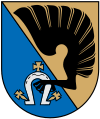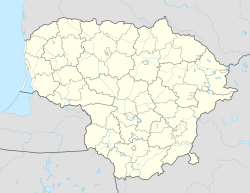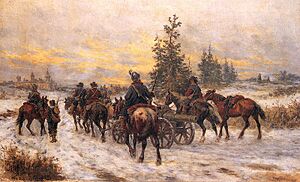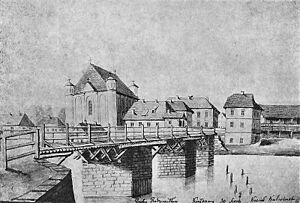Kėdainiai facts for kids
Quick facts for kids
Kėdainiai
|
|||
|---|---|---|---|
|
City
|
|||
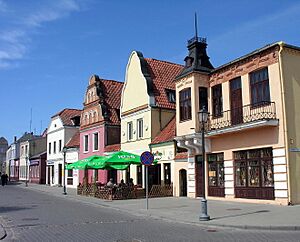
Kėdainiai old town
|
|||
|
|||
| Country | |||
| Ethnographic region | Aukštaitija | ||
| County | |||
| Municipality | Kėdainiai district municipality | ||
| Eldership | Kėdainiai City Eldership | ||
| Capital of | Kėdainiai district municipality Kėdainiai City Eldership |
||
| First mentioned | 1372 | ||
| Granted city rights | 1590 | ||
| Neighbourhoods |
List
Babėnai
Jonušava Justinava Old Town |
||
| Government | |||
| • Type | Municipal Council | ||
| Area | |||
| • Total | 26.97 km2 (10.41 sq mi) | ||
| Elevation | 39 m (128 ft) | ||
| Population
(2023)
|
|||
| • Total | 23,447 | ||
| • Density | 869.37/km2 (2,251.7/sq mi) | ||
| Time zone | UTC+3 (EET) | ||
| • Summer (DST) | EEST | ||
| Postal code |
57xxx
|
||
Kėdainiai is one of the oldest cities in Lithuania. It is about 51 kilometers (32 miles) north of Kaunas. The city sits on the banks of the Nevėžis River. Kėdainiai was first mentioned in a historical record in 1372. As of 2020, about 23,667 people live there. The city's old town area dates back to the 1600s.
Kėdainiai is the main administrative center for the Kėdainiai District Municipality. The exact center of Lithuania is actually in a nearby village called Ruoščiai. This village is part of the Dotnuva area.
Around Kėdainiai, within a few miles, you can find smaller villages. These include Lančiūnava, Kapliai, Labūnava, Josvainiai, Dotnuva, and Kalnaberžė.
Contents
- What Are Kėdainiai's Other Names?
- Exploring Kėdainiai's Past
- How Many People Live in Kėdainiai?
- Getting Around Kėdainiai
- Culture and Fun in Kėdainiai
- Learning in Kėdainiai
- Sports Teams in Kėdainiai
- Who Are the Mayors of Kėdainiai?
- Famous People from Kėdainiai
- Kėdainiai's Sister Cities
- Images for kids
- See also
What Are Kėdainiai's Other Names?
Cities often have different names in various languages. Kėdainiai is known by several other names. In Polish, it's called Kiejdany. In Yiddish, it's Keidan. And in German, it's Kedahnen.
Other ways people have spelled Kėdainiai over time include Kidan, Kaidan, Keidany, Keydan, Kiedamjzeÿ, Kuidany, and Kidainiai.
Exploring Kėdainiai's Past
The Kėdainiai area saw many battles during a big war in the 1600s. This war was between the Polish–Lithuanian Commonwealth and Sweden. It was known as "The Deluge."
In 1655, a short agreement with Sweden was signed in Kėdainiai. It was called the Union of Kėdainiai. Two members of the important Radziwiłł family signed it at their castle in Kėdainiai. Not much of the Radziwiłł castle is left today. However, the crypt (an underground room) of the Calvinist church, built in 1631, holds the family's burial place. Here, you can find the tombs of Krzysztof Radziwiłł and his son Janusz.
Scottish Influence in Kėdainiai
Scottish Protestants started arriving in Kėdainiai in the late 1500s and 1600s. They were encouraged by Anna Radziwiłł, a noblewoman who had converted to their faith. This Scottish community became very important in the city. They stayed until the mid-1800s.
Even today, around the town square, you can see large homes that belonged to Scottish merchants. These are known as the "Scottish Houses." Some examples include the George Anderson House and the John Arnot House.
There was an old local tradition in Kėdainiai. All visitors were asked to bring a stone with them. These stones were then used to help build the town.
In 1790, the first Lithuanian National Cavalry Brigade was stationed in Kėdainiai.
Kėdainiai During World War II
In 1940, the Soviet Union invaded and took control of Kėdainiai. Then, in the summer of 1941, the German Army occupied the town during Operation Barbarossa.
Sadly, on August 28, 1941, a terrible event happened. The entire Jewish community of Kėdainiai was killed. This community had lived in the area for 500 years. German Special Police Battalions carried out these actions, with help from some local Lithuanian people. Before this event, about 3,000 Jewish people lived in Kėdainiai.
Life Under Soviet Control
During the Cold War, Kėdainiai was home to a large Soviet military air base. This base was important for airlifts.
For many years, Kėdainiai was known for its chemical and food processing factories. The Kėdainiai chemical plant, called Lifosa, started working in 1963. It was seen as a big step for Lithuania's industry. However, it released a lot of sulfuric acid into the air. This led to protests about the environment in the 1980s.
Kėdainiai in Independent Lithuania
After a period where things didn't change much, old businesses in Kėdainiai started to grow again. New businesses also opened. This has helped Kėdainiai become an important economic center.
How Many People Live in Kėdainiai?
| Historical population | ||||||||||||||||||||||||||||||||||||||||||||||||||||||||||||||||||||||||||||
|---|---|---|---|---|---|---|---|---|---|---|---|---|---|---|---|---|---|---|---|---|---|---|---|---|---|---|---|---|---|---|---|---|---|---|---|---|---|---|---|---|---|---|---|---|---|---|---|---|---|---|---|---|---|---|---|---|---|---|---|---|---|---|---|---|---|---|---|---|---|---|---|---|---|---|---|---|
|
|
|
|
|
||||||||||||||||||||||||||||||||||||||||||||||||||||||||||||||||||||||||
| Source: 1902, 1923, 1959 & 1970, 1979, 1989, 2001, 2011 | ||||||||||||||||||||||||||||||||||||||||||||||||||||||||||||||||||||||||||||
Getting Around Kėdainiai
Kėdainiai is easy to reach by road. The Via Baltica highway connects it to Kaunas and Panevėžys. You can also get there by train from Vilnius, Klaipėda, and Šiauliai.
The city is also close to Kaunas International Airport. This is the second largest airport in Lithuania. It is located in Karmėlava.
Culture and Fun in Kėdainiai
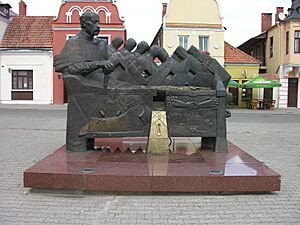
The Kėdainiai Regional Museum opened in 1922. It now has four different locations. These include a Multicultural Centre and the burial place of the Radziwill Dukes. There is also the house of writer Juozas Paukštelis and a museum of wooden sculptures.
Kėdainiai is known as the "cucumber capital" of Lithuania. Because of this, the city holds an annual cucumber festival. It's a fun event celebrating this popular vegetable!
In 2013, the band Bastille filmed a music video in Kėdainiai. It was for their song "Things We Lost in the Fire."
A small group of Polish people live in the Kėdainiai district. They have an association that celebrates Polish culture. They mark Polish Independence Day and Constitution Day. They also organize a festival of Polish culture. A School of Polish Language has been open since 1994.
Learning in Kėdainiai
Kėdainiai has several places for education:
- Jonušas Radvila College (Kėdainių Jonušo Radvilos studijų centras)
- Kėdainiai Atžalynas gymnasium
- Kėdainiai Šviesioji gymnasium
Sports Teams in Kėdainiai
Kėdainiai has a basketball team called BC Nevėžis. They play in Lithuania's main basketball league. The city also has a football (soccer) club, FK Nevėžis. This team is named after the nearby river. They play in the second-tier league. Other football teams include FK Lifosa and FK Nevėžis-2, which is the reserve team for FK Nevėžis.
Who Are the Mayors of Kėdainiai?
The mayor is the leader of the city's government. Here is a list of the mayors of Kėdainiai since Lithuania became independent:
| Mayor | Term of office | Political party | |
|---|---|---|---|
| Took office | Left office | ||
| Independent Lithuania | |||
| Petras Baguška | 1990 | 1994 | |
| Vigimantas Kisielius | 1995 | 1997 | Homeland Union |
| Viktoras Muntianas | 1997 | 2004 | Labour Party |
| Virginija Baltraitienė | 12 November 2004 | 12 December 2005 | Labour Party |
| Nijolė Naujokienė | 2005 | 2011 | Labour Party |
| Rimantas Diliūnas | 2011 | 2015 | Labour Party |
| Saulius Grinkevičius | 17 April 2015 | 2019 | Liberal Movement |
| Valentinas Tamulis | 17 March 2019 | Incumbent | Valentino Tamulio komanda – mūsų krašto sėkmei |
Famous People from Kėdainiai
Many notable individuals have connections to Kėdainiai:
- Jonušas Radvila (1612–1655) - A Lithuanian nobleman and powerful figure.
- Antanas Mackevičius - A priest and a leader in the 1863 uprising.
- Czesław Miłosz - A Polish writer and Nobel Prize winner. He was born in the nearby village of Šeteniai.
- Mikalojus Daukša - A Lithuanian writer and translator.
- Viktoras Muntianas - A Lithuanian politician and former Speaker of the Seimas (Lithuanian parliament).
- Juozas Paukštelis - An author.
- Juozas Urbšys - A Lithuanian diplomat. He was also born in Šeteniai village.
Kėdainiai's Sister Cities
Twin towns or sister cities are partnerships between cities in different countries. They aim to promote cultural and commercial ties. Kėdainiai is twinned with these cities:
Images for kids
-
St. Joseph's church of Carmelites
-
St. George's church, 15th century
See also
 In Spanish: Kėdainiai para niños
In Spanish: Kėdainiai para niños



